APRIL 10, 2024
Lattice Search Includes Foams in the Meta-Materials Library
Design Engine users can now easily find comparable lattice/material combinations that match or outperform common foams, without needing to cross-reference outside resources.
The following foams are available:
- Foam similar to D30 Aero
- Foam similar to D30 Decell
- EVA
- High Density
- Latex
- Memory
- Neoprene
- Packing
- Foam similar to Poron XRD
- Rebond
- VN1000
- VN600
- VN740
Additional helpful information about working with foam comparisons (such as retailer specs for listed foams and information about converting a shore hardness rating to modulus) is available on Carbon Academy.
Example: Common foams are available in the Meta-Materials Library (click “Lattice Search”)
Example: Comparing lattice options for potential foam replacement

Data is based on simulations for lattices and physical testing performed by Carbon for foams. Final part performance may vary. Check out the blog post providing detailed information on Carbon’s performance testing
Outdated lattice performance data deprecated
The “View Cell Analysis” button (sometimes shown in the Strut Lattice operation depending on selected input parameters) is no longer available. This tool referenced an older dataset that has since been superseded by the Lattice Search tool.
Example: Marked elements in this image are no longer available

Rely on Lattice Search to understand performance characteristics of various lattice/material combinations. Click “Request performance data” for any combinations you encounter that are not readily available.
Example: “View unit cell performance” will display up-to-date information from the Lattice Search tool
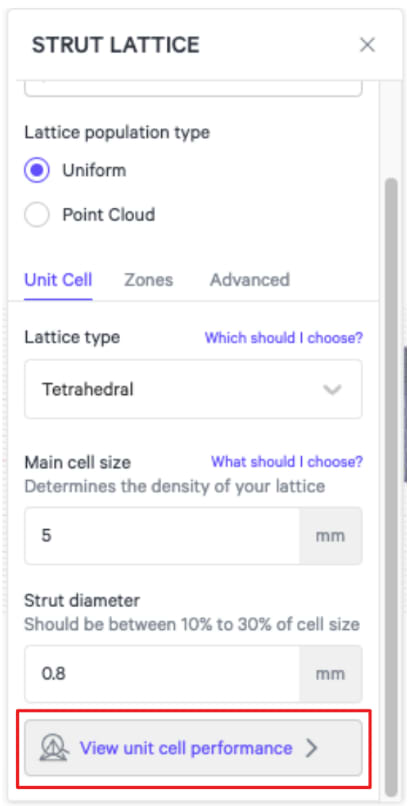
MARCH 27, 2024
Tiled textures
In addition to random “noise” textures (released in Carbon Design Engine™ software in 2023), users can now add decorative tiled textures to meshes. Tiled options appear as new entries in the “Pattern” drop-down menu within the existing Texture operation:
- Cube
- Diamond
- Dot
- Grid
- Hex
- Pyramid
Tiled pattern options:
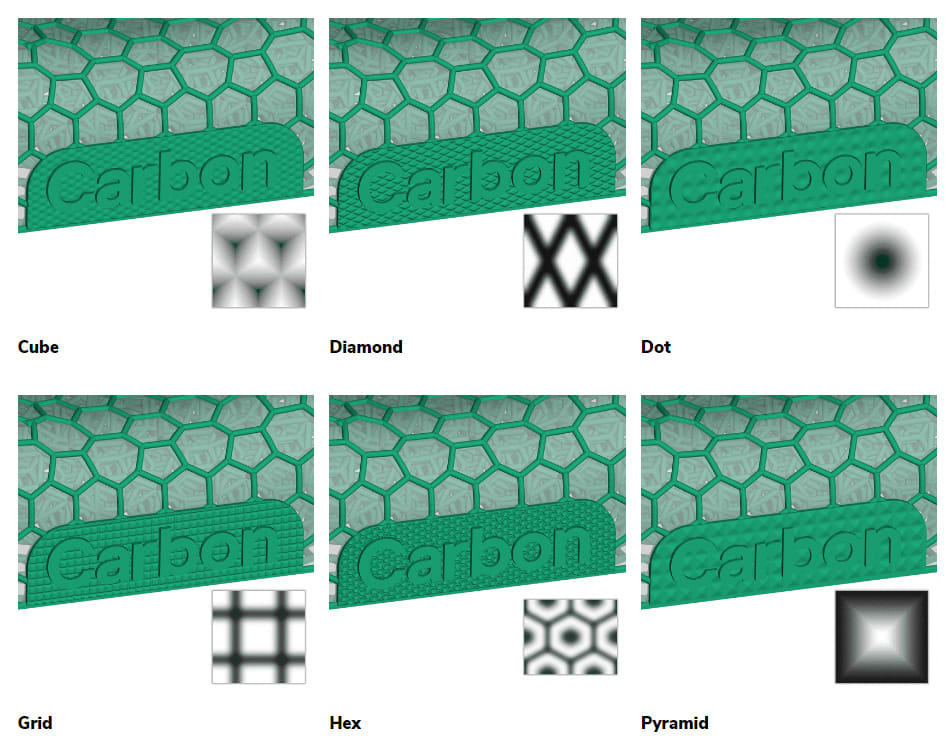
Embedded controls allow users to control the tile size (the size of each individual texture feature) and depth (embossed or debossed) of the pattern. The selected texture can also be inverted to create a negative version of the pattern.
Note that patches must be contiguous for a successful texture application; process unconnected patches as separate Texture operations.
For users familiar with accessing tiled textures with the Print Preparation interface, applying textures in Design Engine should be faster and more robust. Additionally, editing a texture once applied (e.g., changing the pattern, tile size, depth, or boundary decay settings) will return a fast revision result for easy design iterations.
Remesh
Remesh creates a new triangle mesh representation of your geometry with more regular triangles. Remeshing may be useful if a poor-quality mesh is limiting the outcomes of surface operations (e.g., texturing).
Remeshing typically creates more triangles to better represent the desired geometry, and therefore increases file size.
Access Remesh from the new “More mesh tools” drop-down next to the Decimate operation
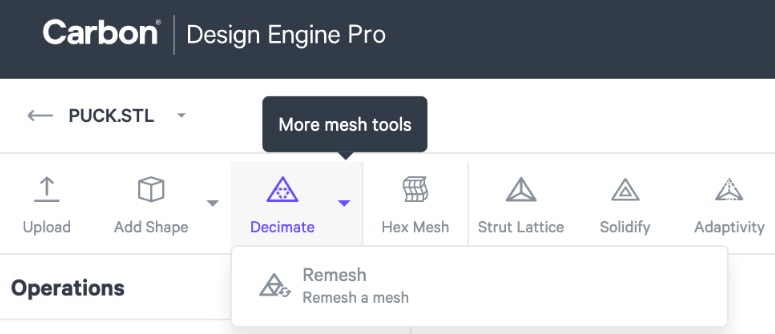
Example: Remeshing a surface for optimal tile texturing
February 7, 2024
Replace Mesh
Any Input Mesh can now be replaced with an alternate mesh using the “Replace Mesh” feature. “Replace Mesh” will swap out the mesh in all operations in which that mesh is selected. This can be useful if you need to swap in an updated version of a file without redoing Operations work, or if you wish to duplicate a previous project to reuse a list of Operations on a different model file.
Note that any patches present on the original mesh will need to be reselected after replacing a mesh.
Replace Mesh is accessed from the menu options available for each Input Mesh.
Additional Part Info
Additional part information is now available for input meshes, including volume, units, and triangle and vertices counts. Click “View Info” from the Meshes menu to access information. Note that some fields may be unavailable for some meshes and/or for some users.

January 31, 2024
Decimate
Large, complex meshes (typically >50 MB and/or >1,000,000 triangles) can be challenging to work with due to long processing times. Decimating a mesh reduces the number of vertices and triangles to simplify mesh geometry.
Consider decimating a mesh whenever your file is >50 MB, has >1,000,000 triangles, or when you know that your model contains more triangles than is necessary to accurately represent the desired geometry. Experiencing lagginess or slow processing might also be an indication that decimation could be helpful.
Decimate is a new option in the top menu, near “Upload” and “Add Shape.” Decimate is intended for input meshes only; Carbon does not recommend decimating generated meshes.
Note that decimation can cause your model to lose detail as triangles are removed/combined. This impact will vary based on geometry; there is no single “right” level of decimation or target number of triangles for all geometries. Decimation is reversible and alterable; consider trying different decimation percentages to get the desired outcome.
Following is an example of how decimation can impact model geometry. The optimal level of decimation for a model will depend on your use case.
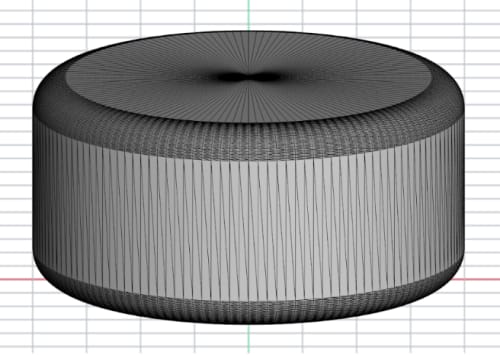


Decimate has been released as Beta functionality at this time; please submit any feedback to support@carbon3d.com.
“Zoom to fit” navigation control (center on this point)
A new “Zoom to fit” navigation control allows you to quickly center a part in the project area and zoom to the extents of the mesh. To access this command, press the F-key, select “Zoom to Fit” from the top-bar View menu, or select “Zoom” from the Meshes menu for a specific input or generated mesh.
Import STEP Files
STEP files can now be uploaded to Design Projects. The entire assembly will be converted to a single triangle mesh.
Note that meshes cannot be downloaded in STEP format (STL, PLY, and OBJ are the available download format options).
January 24, 2024
Reordering operations preserves inputs and dependencies
Moving operations within the operations list now retains inputs and other dependencies.
Note that an operation might need to be updated after it or a related operation is moved; watch for a red marking on an operation to indicate that it requires edits before proceeding.
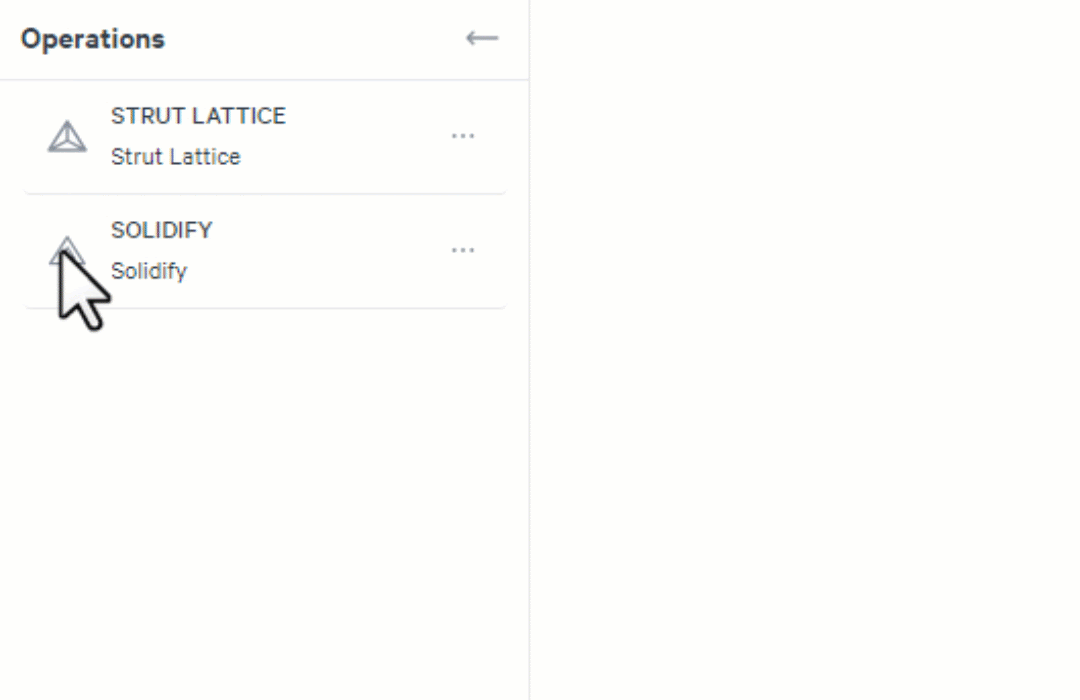
New interface for “Settings” menu
Historically, clicking the Design Project name has opened a menu with various options (eg, Duplicate, Rename).
These options have now been moved to a “Settings” control panel. Here, you can Duplicate a design, Lock a design (see the following section for more information on this new feature), change the project name or material, or Delete a design. Access “Settings” by clicking the Design Project name.
Lock Design
A Design Project can now be locked to protect against unwanted or unintended edits.
Click the design name to launch the “Settings” control panel, then click the “Lock” icon. This action can only be performed by the project owner.
A locked Design Project can still be duplicated by any user with access, and a project owner can unlock a project at any time.
January 10, 2024
Access Lattice Search from Toolbar
Carbon offers a robust Lattice Search tool to help you identify an effective metamaterial (a combination of a material and a lattice design type) for your application based on desired performance and design requirements. Lattice Search can help you get started on a new project by quickly narrowing the vast field of potential lattices to the ones most likely to accomplish your goals.
Lattice Search has long been accessible from within the latticing operation; you can now access Lattice Search directly from the top-bar menu.
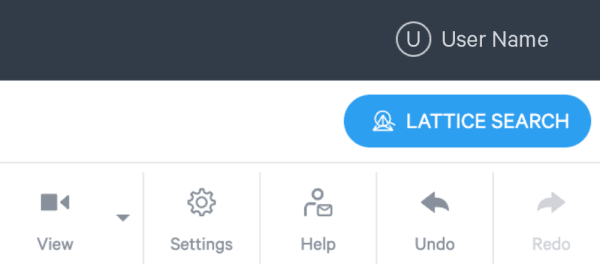
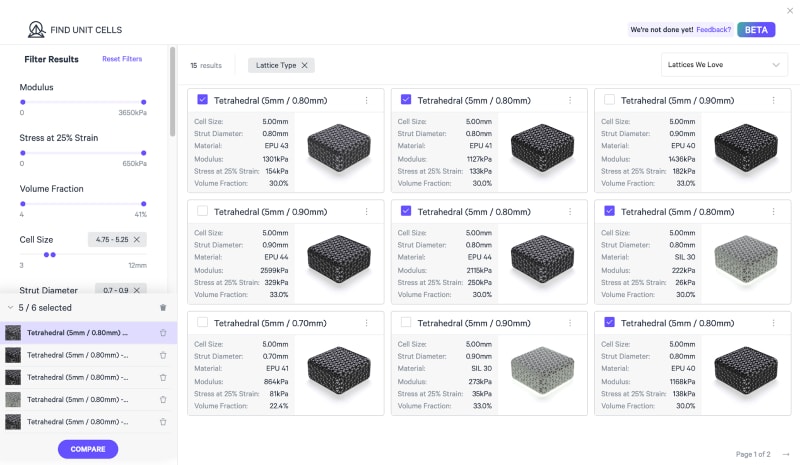
Learn more about using the Lattice Search tool (including as an example of finding a lattice to substitute for a specific foam material) in the Design Engine Tools and Features course.
Prior to January 10, 2024
Release notes were not published for changes to Carbon Design Engine™ software prior to January, 2024.